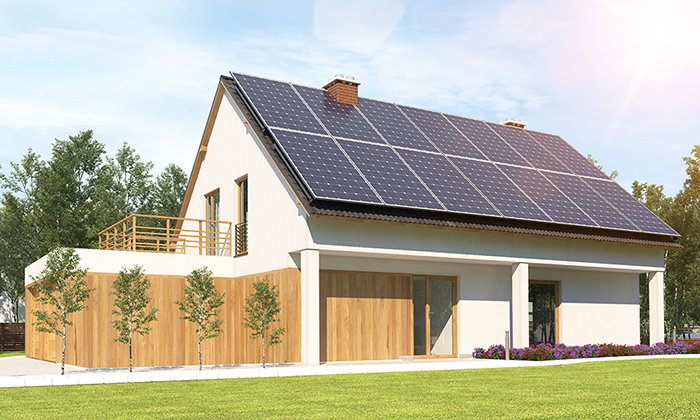There are many benefits to installing solar panels. The following section will describe the installation conditions, costs and time.
1. Understanding solar panels
Solar panels are devices that convert solar radiation into electrical energy by absorbing sunlight. The main material of most solar panels is “silicon”, and its service life is about 25 years.
Among them, batteries are optional accessories, depending on whether the local power company is friendly to solar energy.

2. What are the benefits of installing solar energy?
The general trend
Solar energy is currently the most commonly used green and clean energy. The development and popularization of solar energy has become a century-long plan advocated by most countries in the world, including the United States.
Clean and environmentally friendly
There is no pollution or emission in the process of solar power generation. The emission reduction capacity of one solar panel is equivalent to that of 10 trees.
Economic benefits
The cost of solar energy per kilowatt-hour is as low as 0.09-0.20 yuan, while the electricity price of the national power grid is 0.3 yuan (there are large differences between states). Under the premise of zero investment, monthly electricity bills will immediately drop by 40-60%.
Enjoy tax rebates
In order to encourage the installation of solar energy, the US federal government has just approved an increase in solar energy tax rebates to 30% (previously 26%), and can be rebated together with roof repairs or replacements. 30% tax rebates; there are also state subsidies.Commercial electricity can be rebated by 30%-45% (until 2025).

3. What are the conditions for installing solar energy?
Whether your home is suitable for installing solar energy depends on
The climate conditions and sunshine hours in the area.
The sun-facing roof, if there are branches to block the view, you need to trim or cut down the tree first. Large solar companies will give customers a tree-cutting subsidy of $500-1000.
The roof must meet the basic load-bearing requirements. If the roof is too old, you can consider replacing it with a new one.
4. what is the total cost of installing solar panels?
It is difficult to have a fixed answer to this question, which depends on:
Household electricity consumption;
Roof orientation, south-facing, higher power generation efficiency;
Sunshine time in the area
In the United States, the average electricity consumption of an ordinary household ranges from 3 kilowatts to 8 kilowatts. The expense typically falls in the range of $15,000 to $40,000 (without taking into account subsidies and tax benefits).
The cost per watt lies in the range of approximately 6 dollars to 8 dollars. This cost takes into account various aspects such as the expenses for components, the remuneration for labor, the levies for management, and the fees for licensing among others.
Generally speaking, as the system that is going to be installed becomes larger in scale, the unit price per watt will correspondingly decrease.
Assuming that your average household electricity bill is 160 USD/month, the total cost of upgrading the solar power supply system is about $17,000 (excluding various tax rebates and subsidies, there are large differences in different places).
5. what season is better to install solar energy? How long is the installation period?
Unless there is extremely bad weather, it can be installed all year round; if it is installed in winter, you need to clear the snow first.
It takes about 3-4 months from signing the contract to completing the installation, of which the main time is spent on applying for government licenses and inspections, which generally takes 2-2.5 months.In addition, the number of families applying to install solar energy is growing rapidly, which requires a certain schedule,the installation of the solar energy system itself does not take much time and can be completed in 1-2 days.
Therefore, if you apply for a schedule now, it will be installed in the spring of next year, just in time for the increase in photovoltaic power generation efficiency.
6. Why should solar energy be installed as early as possible?
First of all, of course, the earlier you install it, the earlier you can enjoy the benefits.
In addition, it is currently a period of national policy support, and you can enjoy a large tax rebate.
However, these policies are time-limited. For example, the tax rebate policy for commercial solar energy ends in 2025.
7. After installing solar energy, do you still need to connect to the power company's grid?
After installing a solar power generation system, your home power supply system generally still needs to be connected to the power company's power grid, which has the following functions:
Help you store electricity
Solar energy can only generate electricity during the day, and this electricity is generally not consumed immediately. The excess electricity will be returned to the power grid through the inverter for storage (actually it is transferred to other places by the power grid).
When the solar power is not enough (such as cloudy days or at night), it will be transferred back from the power grid.
How to know when to store electricity and when to use electricity? When the meter is reversed, it means that the solar system is generating electricity and storing electricity to the power grid; when it is forward, it means that your home is using the power grid.
Make sure you have electricity at any time
If your electricity consumption exceeds the storage capacity, you can continue to use the power grid. Of course, the excess electricity fee is calculated according to the price of the power company.
The power grid will have a surplus of your solar power generation every year. If there is a surplus, you have two options: accumulate it and use it slowly next year, or sell it to the power grid (the price is 0.05-0.08 per kWh).
Of course, the “reservoir” service provided by the power company is not free. You need to pay them 7 dollars per month for access to the grid.








